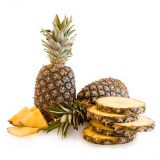Melon (per unit)
These melons are grown in Cuiper (Valencia, Spain), orchard with long tradition of slightly saline lands where they grow these sweet fruits admired for the delicious taste of the flesh.
Both the epidermis and the flesh are variable in colour according to the group because the skin can be white, grey, green or yellow and rough, smooth or with reticulated texture. Its flesh is aromatic with soft texture and variety of colours and can be green, yellow, pink and other colours.
The size of melons is highly variable existing varieties weighing only 400 grams and others can reach 20 kilograms.
History and origin of melon
To talk about the origin of melons we can mention two options since experts do not agree in one unique origin. Some date its origins in South Asia while others claim that his birth was in Africa as there are representations of this fruit in Egyptian tombs in 2400 BC.
In ancient times it was praised as beneficial fruit such as the sun, a master work of Apollo.
The melon was introduced in Spain on the trade routes that reached the port of Cartagena (formerly the port of Carthage) in the centuries of Roman rule in the Iberian Peninsula. There have been found writings of horticulture manuals on the domain of the Romans as well as the Muslims that already mention melons. The Romans served this fruit with musk to enhance its flavour.
In the fifteenth century melons appeared in France and were served in the court accompanied by Muscatel. As it happens with other fruits was Christopher Columbus and his sailors who introduced them to America.
Keep in mind that at that time the so-called melon was no larger than an orange and today far outweigh these since they were developed in many cases under investigations and improvements so that they achieved the current large size and number of varieties we have available nowadays in the markets.
Properties and benefits of melon
- The melon has significant water content; it is refreshing and an excellent diuretic food that helps eliminate toxins from the body.
- Its vitamin A and E gives us great benefits for the skin, hair, nails and antioxidant properties to combat aging of cells.
- It is also a good source of fibre improves intestinal transit.
- Its content of beta carotene helps us achieve the desired tanning promoting skin pigmentation.
- It prevents skin blemishes due to the elimination of toxins that causes guilty of these spots.
- Its vitamin A helps people suffering from dry mucous membranes and skin improvement.
- It is a diuretic fruit acts as a laxative and removes excess toxins from the body helping to neutralize the acidity.
- Potassium content controls heart rate and blood pressure preventing heart disease.
llevo tiempo comprando aquí y salvo en una ocasión siempre me han llega melones muy jugosos.Dolores Fernandez Antequera






